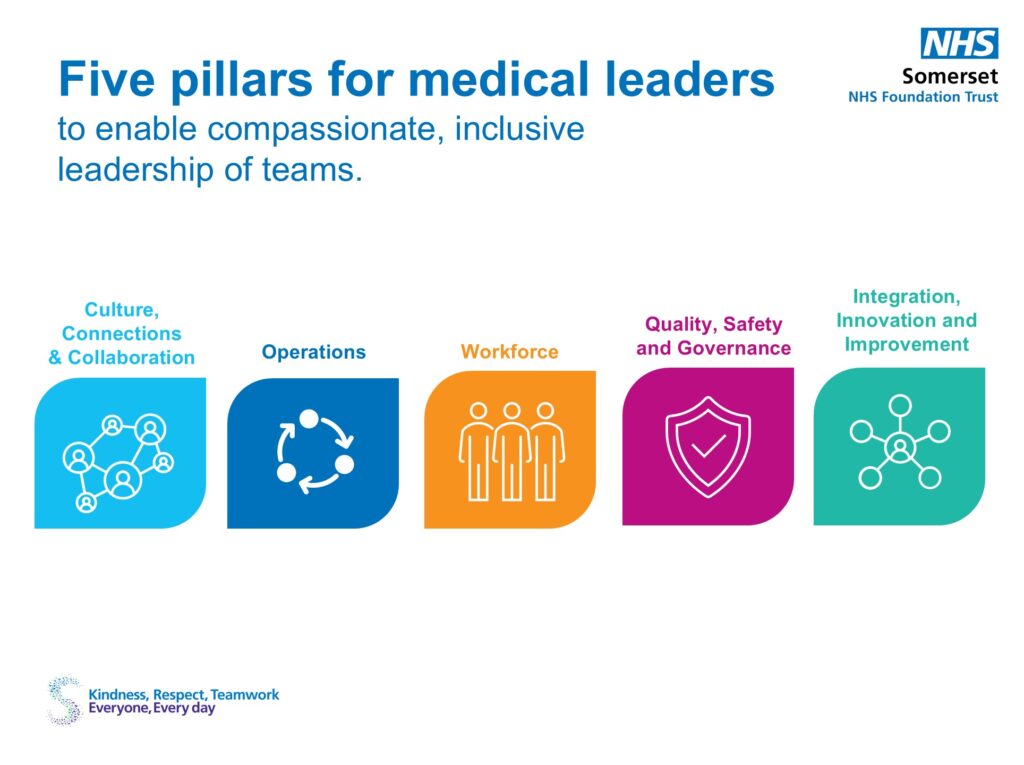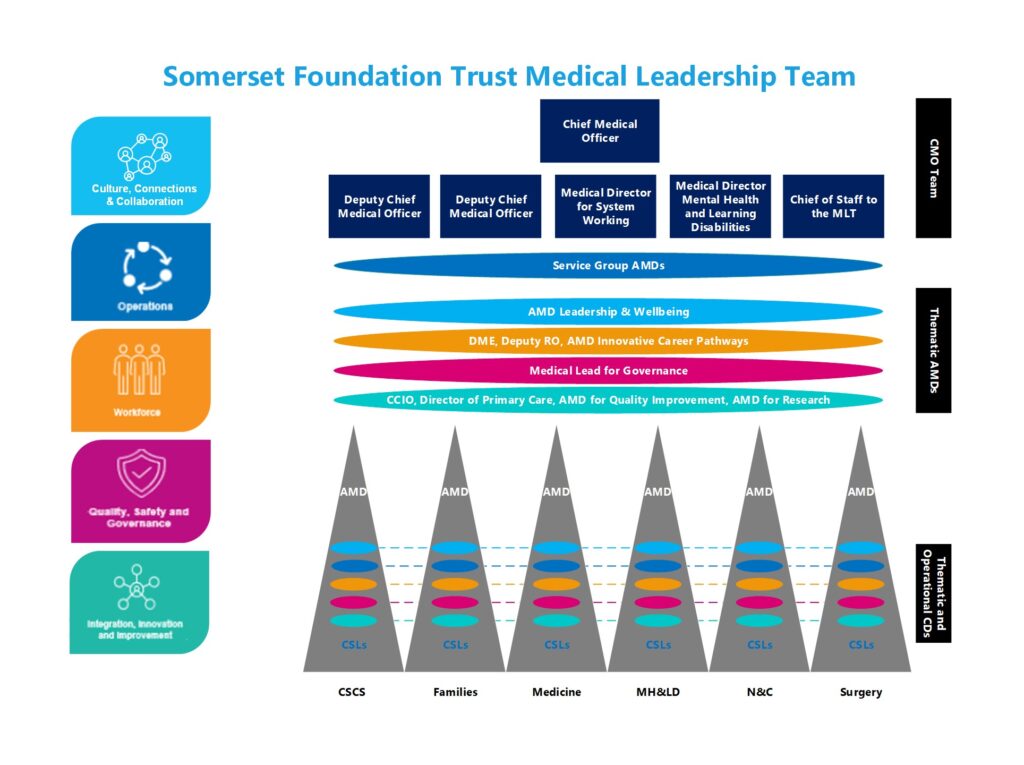As colleagues in the NHS, our priority is patient care that meets the needs of every person, regardless of their background, identity or income. This is easy to say yet report after report shows us it’s hard to do in practice.
We know quality of care is linked to workplace inclusion, colleague wellbeing, kindness and compassion.( 1, 2)
If inclusion and wellbeing are prioritised at every level of an organisation, a culture can be created where colleagues succeed equitably and treat one another with kindness. When we get this right, we’re more likely to see the first patient of the shift and the last patient of the shift receive the same kind, compassionate, safe, high-quality care.
And yet, we continue to see the rise in burnout and distress amongst doctors and the wider workforce. The NHS staff survey (3) shows a significant number of our colleagues feel they have been bullied or discriminated against. With pressure across the NHS on staffing numbers and finance; wellbeing, inclusion and kindness are even more important but can quickly disappear down the priority list.
The research (4 5 6) points towards an approach that works – by building kindness, inclusion and wellbeing into how organisations operate and are led. This means every individual is held accountable for these outcomes, rather than being a ‘nice to have’.
A new model for medical leadership
We have tried to meet this challenge, with a new model for medical leadership that is a practical application of this research – and is designed to ensure kindness and inclusion are central to our medical leadership roles.
Our context
Somerset is a unique trust comprising two acute hospitals, a community and mental health trust and 16 GP practices covering a population of around 500,000 with 750 senior doctors (SAS grade or consultant ).
Our aims
We set out to design a medical leadership model that provides clarity around the responsibilities, skills and behaviours expected of our leaders. Doctors taking on leadership roles often struggle to balance their leadership responsibilities alongside clinical practice. The two skill sets are also very different (5), a new leadership role can be a steep learning curve. Our aim was to provide a framework that:
- Enables all colleagues to have clarity in their roles.
- Clearly embeds kindness, compassion and inclusion as core responsibilities and accountabilities across all our leadership roles.
- Address barriers to medical leadership roles and ensure the diversity of our medical leaders reflects the diversity of all our clinicians.
- Ensures consistent, fair and transparent recruitment into and accountability of leadership roles.
- Provides guidance on development opportunities that build kind, compassionate and inclusive leadership skills.
Our five pillars
Through consultation and iterative development, we have developed five pillars of medical leadership of equal importance which can be seen in the image below. Our aim was to create something that means something. Something that is both memorable and practical. The intention is that even in times of pressure, we don’t lose sight of all five areas of leadership.

We have designed these based on available literature, data and conversations. We were also inspired by a case study from Macquarie University (7) in Australia – where they completely reimagined the academic promotions process which drove different behaviours, changed how work was valued, and improved diversity. This reminds us change is possible.
Under each of the pillars, sit clear documentation of the key responsibilities and accountabilities. We also clearly articulate the skills and behaviours we expect to see. We give detail on how this might develop and change across the varied levels of leadership and we also provide bespoke learning resources and signpost to relevant development opportunities.
Our new leadership structure

We have created thematic associate medical director (AMD) roles that work across the service groups, focusing on a pillar (as shown above).
- Culture, connections & collaboration is led by AMD for wellbeing and leadership
- Operations are led by service group AMD
- Workforce is a collaboration between DME (director of medical education), Responsible officer and AMD for innovative careers.
- Quality, safety and governance is led by AMD
- Integration, innovation and improvement – AMD for quality improvement together with the chief clinical information officer (CCIO), AMD for research, and our director of primary care
This ensures that when under operational and workforce pressures we enable innovation, service development and continue to prioritise colleague wellbeing. These AMD support the operational AMD and regularly update the CMO team. For example, in wellbeing and leadership a sampled monthly data collection on wellbeing and burnout enables us to review areas of challenge and plan interventions. The image above depicts this.
Our medical leadership is completed by the chief medical officer team who comprise four medical directors and our chief of staff. We form leadership teams as a senior doctor (SAS grade or consultant), with an operational manager, and a senior nurse or allied health professional (AHP).
How we’re bringing our framework to life
We intend to further use the framework at every stage of medical leadership development. From guiding our enhanced senior doctor induction professional development programme through to recruitment of our senior medical directors.
From when we design a role, write the job description, plan how to advertise, application process through shortlisting and interview into leadership role, we aim to be inclusive in design to support a diversity of applicant. Once in post we aim to provide robust induction, ongoing coaching, mentoring and peer learning forums. An annual leadership review with 360 leadership feedback focusing on development will support this. We also recently surveyed all senior doctors asking what we need to change to enable our leadership to be more kind, compassionate and inclusive (publication in peer review).
We aim to further develop the systems behind our leadership pillars and plan to test and learn as we go. We would love to connect with others to design leadership roles fit for the future and support colleagues to thrive in those roles.
So, we ask again – are you brave enough to join us?
References and Further Reading
1 caring-for-doctors-caring-for-patients_pdf-80706341.pdf
3 National results across the NHS in England | NHS Staff Survey
4 The Kind Organisation | BMJ Leader
7 Women in academia take aim at sexism, gender inequality in university research fields – ABC News
Authors
Anna Baverstock is a consultant community paediatrician looking after children and young people with complex neuro-disability and their families. She also has a leadership role as associate medical director looking at medical leadership and wellbeing. A member of civility saves lives group, a senior consultant at Doctors training and a passionate advocate of kindness in healthcare.
I have read and understood the BMJ Group policy on declaration of interests and declare the following interests: Senior consultant at doctors training, speaker with civility saves lives
Harriet Jones is Head of Inclusion at Somerset NHS Foundation Trust, leading the organisation’s strategic approach to inclusion. She has led equity and inclusion work for over 10 years in Higher Education and the NHS.
I have read and understood the BMJ Group policy on declaration of interests and declare the following interests: none.
Petra Jankowska is a consultant clinical oncologist looking after people with lung and head & neck cancers. She leads on compassionate and inclusive medical leadership for Somerset Foundation Trust and is medical director of professional practice at the Royal College of Radiologists. She has a passion for inclusive and kind leadership and strongly believes in leading by example.
I have read and understood the BMJ Group policy on declaration of interests and declare the following interests: Occasional honoraria from AZ, MSD, BMS for speaker fees and advisory boards.
Jeremy Smith is the Chief of Staff to the Chief Medical Officer at Somerset Foundation Trust. He has worked in leadership roles in the NHS and the Civil Service for over twenty years and is a passionate believer in the importance of good leadership and wellbeing.
I have read and understood the BMJ Group policy on declaration of interests and declare the following interests: none.
Mike Walburn is a consultant anaesthetist who specialises in the care of children, young people and adults with learning disabilities. He is also the deputy chief medical officer of a combined acute, community, mental health and primary care trust. He has a passionate belief in the importance of kindness and inclusion as the cornerstone of leadership development for medical colleagues.
I have read and understood the BMJ Group policy on declaration of interests and declare the following interests: none.